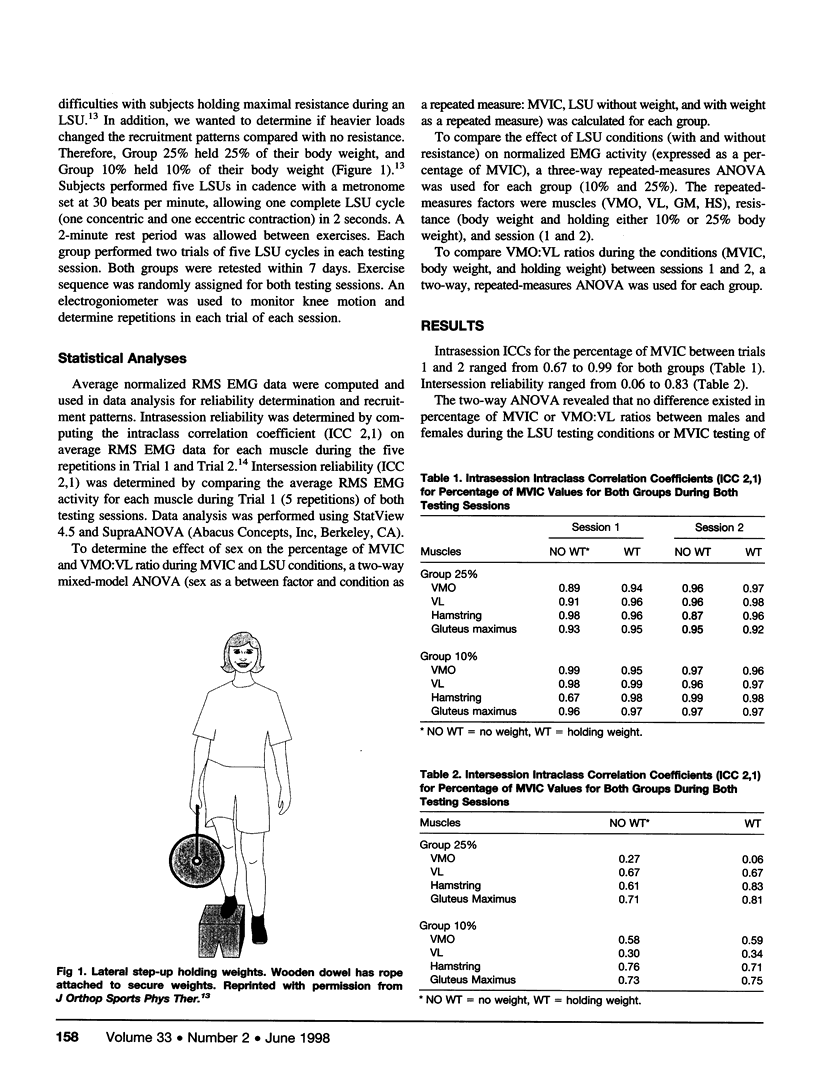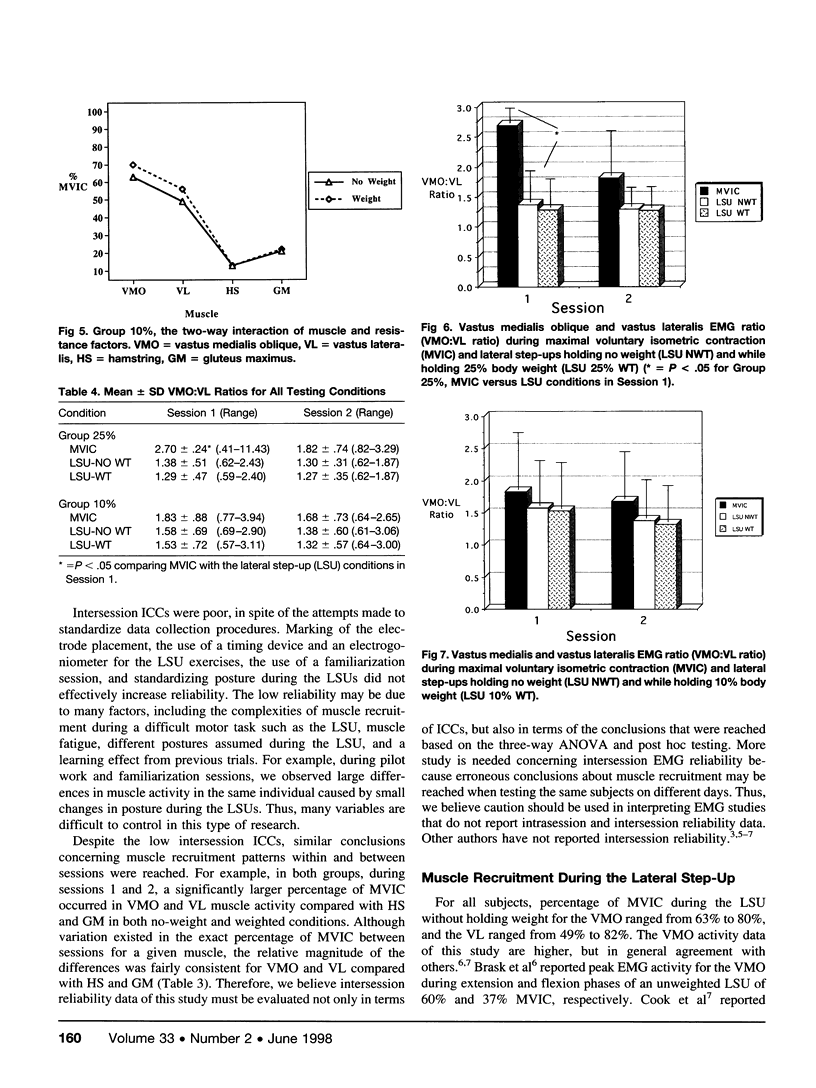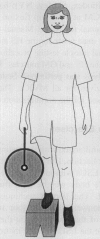Abstract
Objective:
To determine 1) the electromyographic (EMG) reliability within and between testing sessions; 2) the effect of sex on the EMG activity of the vastus medialis oblique (VMO), vastus lateralis (VL), hamstring (HS), and gluteus maximus (GM) and VMO:VL ratios during maximal voluntary isometric contraction (MVIC) and lateral step-up (LSU) conditions; and 3) the muscle recruitment and VMO:VL ratios during MVIC and LSU conditions.
Design and Setting:
Subjects participated in a familiarization session and two testing sessions in which they performed a 20.32-cm (8-in) LSU with and without resistance while the EMG activity was monitored for the VMO, VL, HS, and GM muscles.
Subjects:
Nineteen subjects performed LSUs holding 25% body weight (Group 25%), and 13 subjects performed LSUs holding 10% body weight (Group 10%). There were 32 subjects total: 19 males and 13 females.
Measurements:
Statistical analyses included a two-way analysis of variance (ANOVA) to compare sex and testing conditions for percentage of MVIC and VMO:VL ratios; three-way repeated-measures ANOVA to compare muscle, resistance, and session factors for percentage of MVIC; and a two-way repeated-measures ANOVA to compare conditions and session factors for VMO:VL ratios. These analyses were performed for both groups.
Results:
Reliability results revealed good intrasession and poor intersession intraclass correlation coefficients. No difference existed in muscle recruitment or VMO:VL ratios between males and females for either group. The three-way ANOVA revealed a significant two-way interaction (muscle × resistance) for both groups. Post hoc testing revealed the following EMG recruitment patterns: VMO > HS, GM, VL;VL > HS, GM; HS = GM for both groups. For Group 25%, the two-way ANOVA revealed greater VMO:VL ratios during MVIC for session one than for LSU.
Conclusions:
Intrasession reliability was higher than intersession reliability, but similar conclusions were reached concerning muscle recruitment in both testing situations. No sex differences existed in recruitment patterns. The LSU requires greater VMO and VL recruitment than HS and GM recruitment. In addition, VMO:VL ratios varied tremendously in a group of asymptomatic subjects, which challenges the theory of a “normal” VMO:VL ratio of 1:1 in asymptomatic subjects.
Keywords: hamstring, gluteus maximus, VMO, VL, VMO:VL ratios
Full text
PDF






Images in this article
Selected References
These references are in PubMed. This may not be the complete list of references from this article.
- Brask B., Lueke R. H., Soderberg G. L. Electromyographic analysis of selected muscles during the lateral step-up exercise. Phys Ther. 1984 Mar;64(3):324–329. doi: 10.1093/ptj/64.3.324. [DOI] [PubMed] [Google Scholar]
- Gryzlo S. M., Patek R. M., Pink M., Perry J. Electromyographic analysis of knee rehabilitation exercises. J Orthop Sports Phys Ther. 1994 Jul;20(1):36–43. doi: 10.2519/jospt.1994.20.1.36. [DOI] [PubMed] [Google Scholar]
- Henning C. E., Lynch M. A., Glick K. R., Jr An in vivo strain gage study of elongation of the anterior cruciate ligament. Am J Sports Med. 1985 Jan-Feb;13(1):22–26. doi: 10.1177/036354658501300104. [DOI] [PubMed] [Google Scholar]
- Isear J. A., Jr, Erickson J. C., Worrell T. W. EMG analysis of lower extremity muscle recruitment patterns during an unloaded squat. Med Sci Sports Exerc. 1997 Apr;29(4):532–539. doi: 10.1097/00005768-199704000-00016. [DOI] [PubMed] [Google Scholar]
- Jaramillo J., Worrell T. W., Ingersoll C. D. Hip isometric strength following knee surgery. J Orthop Sports Phys Ther. 1994 Sep;20(3):160–165. doi: 10.2519/jospt.1994.20.3.160. [DOI] [PubMed] [Google Scholar]
- Lutz G. E., Palmitier R. A., An K. N., Chao E. Y. Comparison of tibiofemoral joint forces during open-kinetic-chain and closed-kinetic-chain exercises. J Bone Joint Surg Am. 1993 May;75(5):732–739. doi: 10.2106/00004623-199305000-00014. [DOI] [PubMed] [Google Scholar]
- Worrell T. W., Borchert B., Erner K., Fritz J., Leerar P. Effect of a lateral step-up exercise protocol on quadriceps and lower extremity performance. J Orthop Sports Phys Ther. 1993 Dec;18(6):646–653. doi: 10.2519/jospt.1993.18.6.646. [DOI] [PubMed] [Google Scholar]



